Dogs love tennis balls because they tap into their primal instincts and provide a multi-sensory experience.
The fuzzy texture feels great in their mouths, while the unpredictable bounces mimic prey movement, triggering their chase instinct.
The bright color and distinctive smell make tennis balls easy to track, and their size is perfect for most dogs to carry. Plus, playing fetch with a tennis ball is a fantastic way to bond with your pup, providing both physical exercise and mental stimulation.
It’s a fun, rewarding activity that releases feel-good hormones in your dog’s brain.
There’s even more to uncover about your furry friend’s favorite toy!
The Primal Chase Instinct
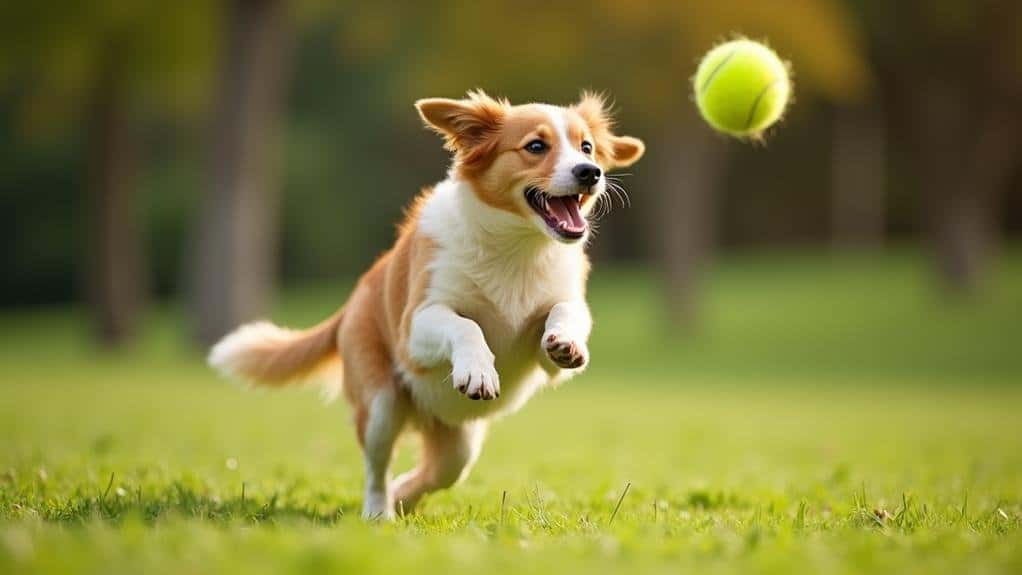
Rooted in their wolf ancestry, dogs’ love for chasing tennis balls taps into a primal instinct that’s been honed over millennia.
When you toss that fuzzy yellow sphere, you’re not just playing fetch – you’re awakening your pup’s inner wolf!
Here’s why dogs love tennis balls so much:
- Chase instinct: The erratic, bouncy movement of a tennis ball mimics the unpredictable flight of prey, triggering your dog’s natural chase response.
- Prey drive: Some breeds, especially those bred for hunting like Labradors and spaniels, have a higher prey drive. For them, chasing a tennis ball is like pursuing their next meal – minus the actual hunting part!
- Physical and mental workout: Chasing and retrieving tennis balls provides both physical activity and mental stimulation. It’s a fun way for your furry friend to exercise their body and mind.
- Reward system: When your dog successfully retrieves the ball, their brain releases feel-good chemicals like endorphins and dopamine. This positive reinforcement keeps them coming back for more.
Texture and Sensory Stimulation

Beyond the thrill of the chase, tennis balls offer dogs a sensory smorgasbord that keeps them coming back for more.
The fuzzy felt coating provides a unique texture that’s irresistible to your pup’s paws and mouth.
It’s not just about the feel, though – this rough surface acts like a gentle toothbrush, massaging your dog’s gums and promoting dental health while they chew.
You’ll notice your furry friend can’t get enough of that satisfying grip and comfortable chew. The size of a tennis ball is perfect for most dogs, allowing them to carry it around with ease and chomp down without any choking risks.
But there’s more to it than just texture and size.
Have you ever wondered why your dog seems to go crazy for tennis balls? It’s the scent! The natural rubber smell is like catnip for canines, ramping up their excitement during playtime.
As your pup chews and carries the ball around, it picks up familiar outdoor scents, creating a comforting olfactory experience that keeps them engaged and stimulated.
It’s no wonder tennis balls are a doggy favorite!
Unpredictable Bounces Excite Dogs
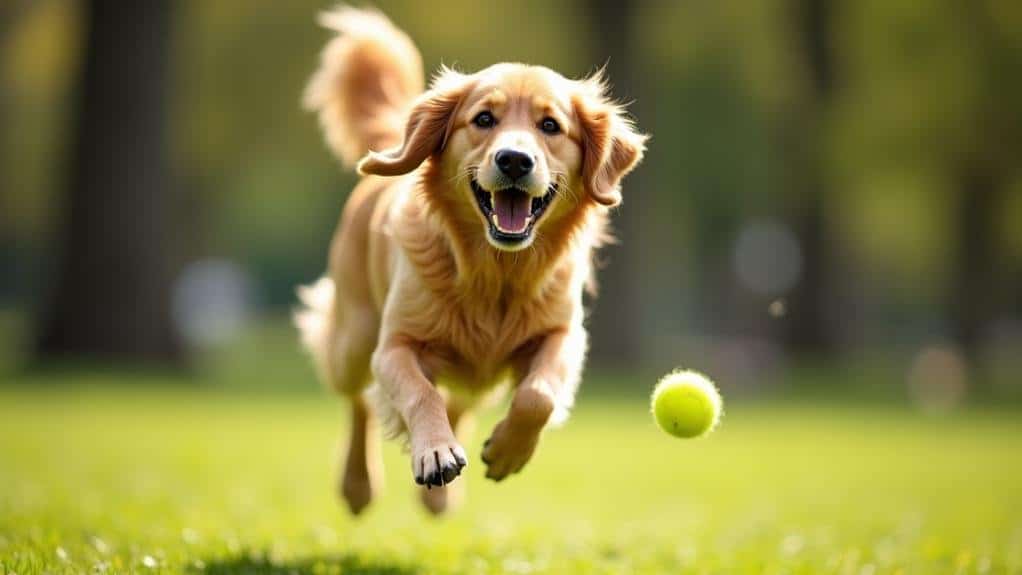
A tennis ball’s bounce is a canine thrill ride. When you toss that fuzzy yellow sphere, you’re not just playing fetch – you’re tapping into your dog’s natural chase instincts.
The unpredictable movement of a tennis ball mimics the erratic behavior of prey, turning a simple game into an exciting hunt.
Here’s why tennis ball bounces keep your pup engaged and mentally stimulated:
- Unexpected trajectories: The lightweight design of tennis balls creates unpredictable bounces, challenging your dog’s agility and speed.
- Auditory excitement: Your furry friend’s acute sense of hearing picks up the unique sound of a bouncing ball, adding an extra layer of excitement to the chase.
- Instinctual satisfaction: Chasing and catching a tennis ball satisfies your dog’s ancestral hunting behaviors, making it both fun and instinctually rewarding.
As you watch your dog dash after a bouncing tennis ball, you’re witnessing the thrill of the chase in action.
It’s not just a game – it’s a full-body, multi-sensory experience that keeps your pup physically active and mentally sharp.
Scent and Olfactory Attraction
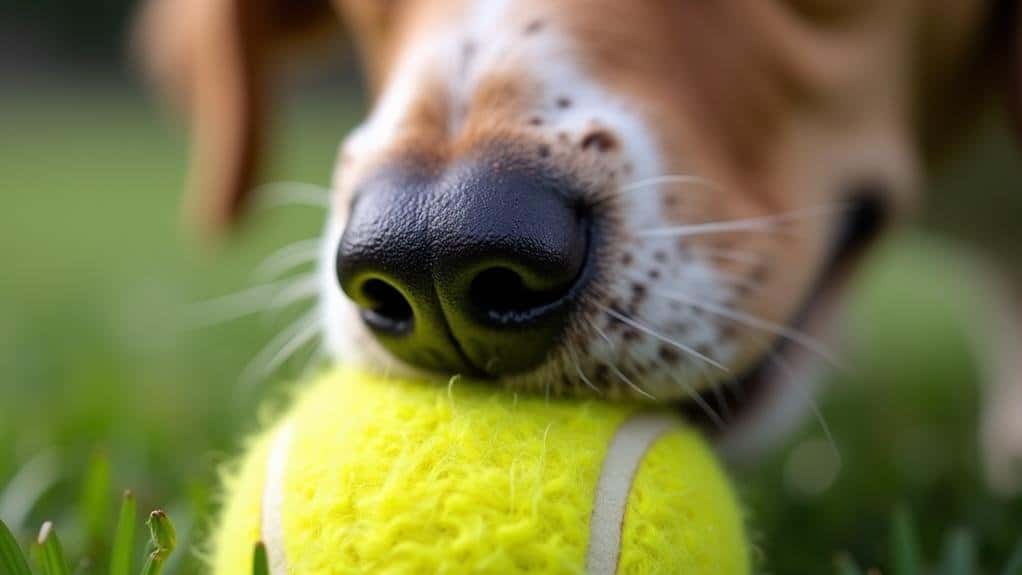
While a tennis ball’s bounce captivates your dog’s eyes, its scent tells an equally enticing story.
Your furry friend’s nose is incredibly powerful, with a sense of smell up to 100,000 times more acute than yours.
This heightened sensitivity allows them to pick up on the natural rubber scent of tennis balls, creating an irresistible allure.
The Scent Symphony:
- Familiar aromas: Grass, dirt, and slobber accumulate on tennis balls, forming a comforting olfactory experience for your pup.
- Memory bank: Chewed balls become a treasure trove of sniffable memories, linking scent to joyful playtime experiences.
- Brain engagement: The olfactory stimulation from tennis balls triggers positive emotional responses in your dog’s brain.
This unique combination of scents enhances your dog’s motivation to engage in fetch activities. As they play, the ball’s aroma becomes increasingly enticing, creating a self-reinforcing cycle of excitement and happiness.
It’s no wonder your four-legged friend can’t resist the allure of these fuzzy, scent-filled spheres! So next time you’re playing fetch, remember that your dog’s nose is working overtime to make the experience even more enjoyable.
Visual Appeal of Tennis Balls
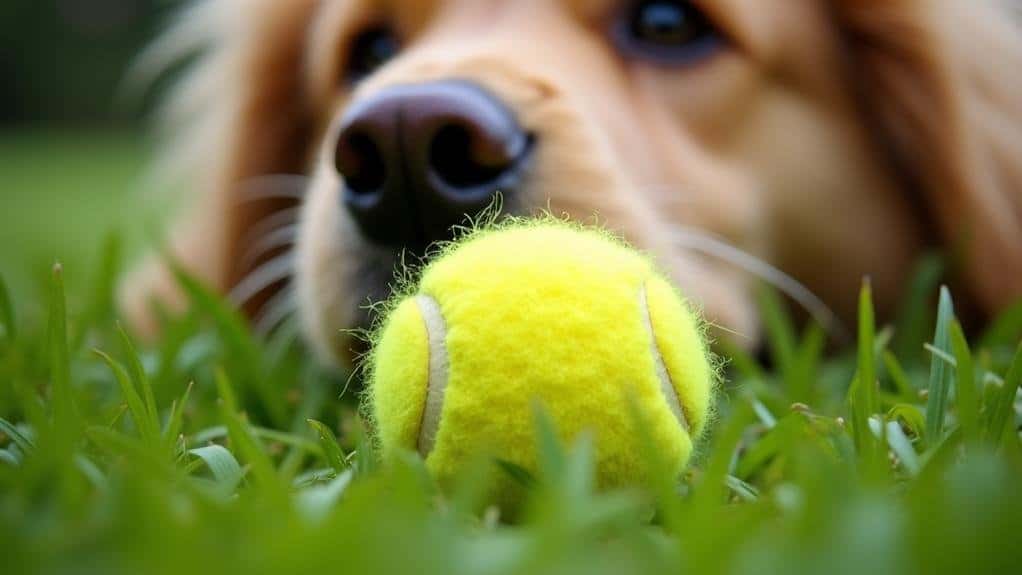
Visibility plays an essential role in your dog’s love affair with tennis balls. When you’re out playing fetch with your furry friend, you mightn’t realize how the bright color of the ball enhances your dog’s ability to track and chase it.
Dogs have a limited color spectrum, but they’re particularly drawn to blue and yellow hues. This makes the neon green or bright yellow of tennis balls stand out like a beacon against the green grass.
The visual appeal of tennis balls isn’t just about looking pretty; it’s about tapping into your dog’s natural instincts. Here’s why tennis balls are so visually enticing:
- High contrast: The ball’s color prevents it from blending into the environment, making it easy for your pup to spot.
- Movement mimicry: As the ball bounces and rolls, it triggers your dog’s prey drive, simulating the movement of small animals.
- Enhanced engagement: The ball’s visibility contributes to a more exciting fetch game, keeping your dog interested and active.
Exercise and Mental Stimulation
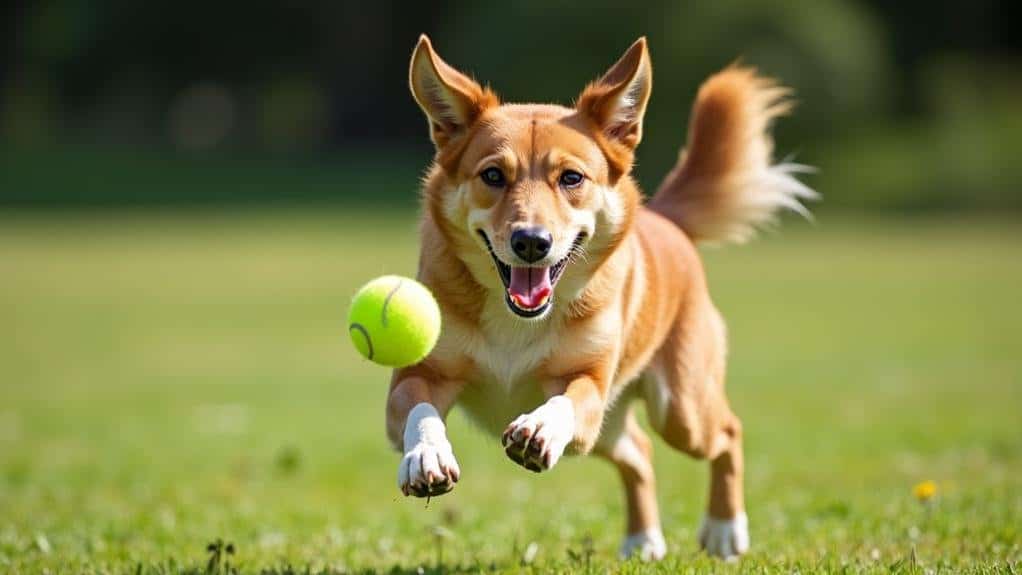
Tennis balls serve as a powerful tool for canine fitness and cognitive engagement. When you play fetch with your furry friend, you’re not just tossing a ball; you’re providing a full-body workout that burns excess energy and promotes cardiovascular health.
The unpredictable bounce of tennis balls keeps your dog mentally stimulated and engaged throughout playtime, challenging their problem-solving skills and reflexes.
Here’s why tennis balls are great for exercise and mental stimulation:
- Physical benefits:
- Vigorous exercise burns calories
- Improves cardiovascular health
- Maintains healthy weight and muscle tone
- Mental stimulation:
- Unpredictable bounces keep dogs engaged
- Activates problem-solving skills
- Alleviates boredom and reduces anxiety
Bonding Through Playtime
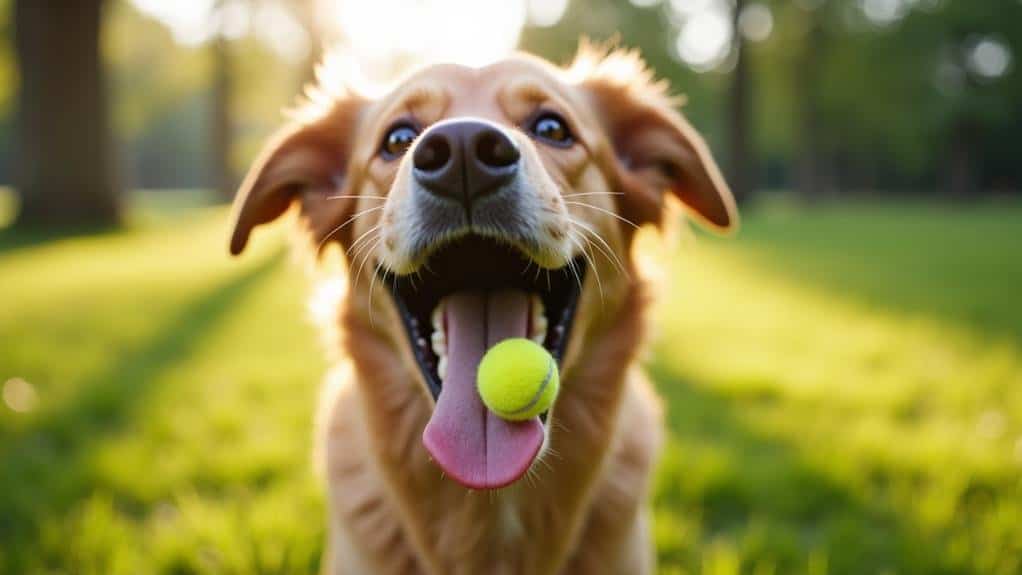
Beyond the physical and mental benefits, playing fetch with tennis balls offers a unique opportunity for bonding between dogs and their owners. This shared activity strengthens your emotional connection with your furry friend, enhancing trust and companionship in ways you mightn’t even realize.
When you engage in regular fetch games with your dog, you’re investing in quality time together. This playtime is essential for building a strong relationship and learning to understand each other’s cues. As you toss the tennis ball and your dog enthusiastically retrieves it, you’re creating joyful experiences that contribute to a positive emotional bond.
The physical activity involved in fetch also helps your dog burn off excess energy, leading to a more relaxed and affectionate companion. This can improve your overall interaction and your dog’s behavior.
Plus, the unpredictable bouncing of the tennis ball keeps your pup mentally engaged, adding an extra layer of excitement to your bonding time.
Size and Mouth Compatibility
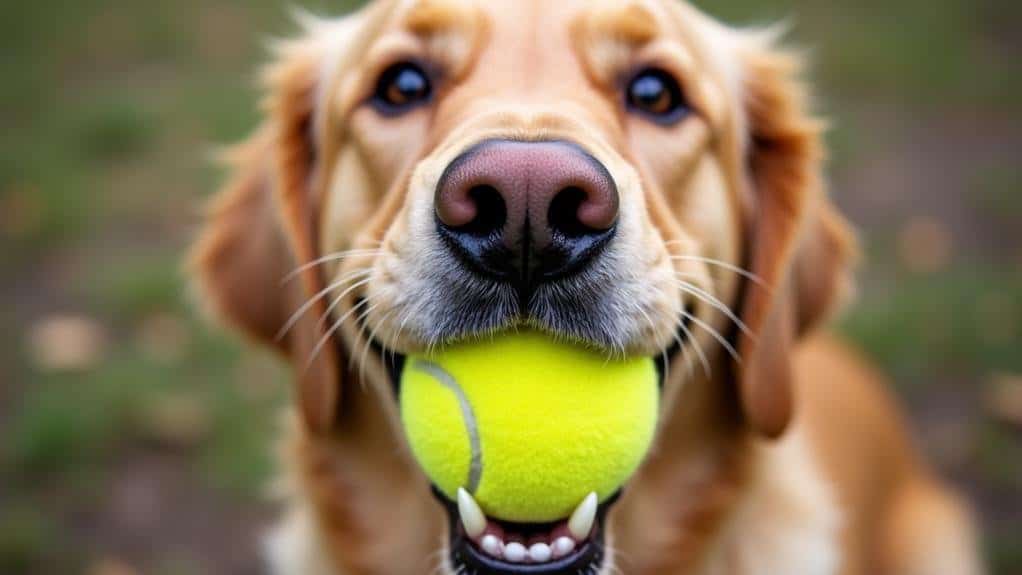
One of the key reasons dogs love tennis balls is their perfect size and mouth compatibility. You’ll notice that tennis balls are designed with a standard size of about 2.7 inches in diameter, which fits comfortably in the mouths of most medium to large dogs. This size isn’t just a coincidence; it’s carefully crafted to prevent choking hazards while still allowing for easy carrying and retrieval during playtime fun.
Even smaller breeds can handle tennis balls with relative ease if you supervise their play. The felt covering on tennis balls provides a satisfying grip for your furry friend, making it easier for them to pick up and hold the ball. This texture is irresistible to dogs and encourages them to keep playing.
When it comes to chewing on tennis balls, the soft yet firm composition caters to your dog’s natural instincts without causing significant damage to their teeth over time. However, it’s important to monitor your pup during play to guarantee they don’t overdo it.
Here are some benefits of tennis balls for dogs:
- Lightweight for easy tossing
- Satisfying texture for gripping
- Safe size for most breeds
- Durable for extended play sessions
Positive Reinforcement and Rewards
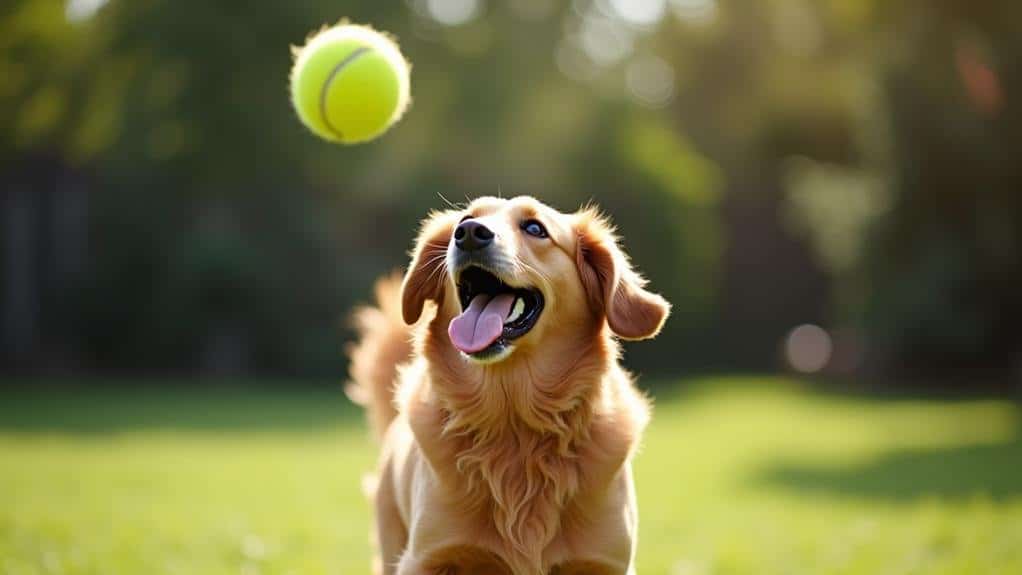
When your dog chases after a tennis ball, they’re not just engaging in physical exercise; they’re participating in a powerful form of positive reinforcement. This simple game of fetch is actually a complex system of rewards that keeps your furry friend coming back for more.
Here’s why tennis balls are so appealing to dogs:
1. Instant Gratification
Every time your dog successfully retrieves the ball and brings it back to you, they’re rewarded with praise, treats, or more playtime. This positive reinforcement creates a feel-good loop in their brain, encouraging them to repeat the behavior.
2. Bonding Experience
Fetch isn’t just fun; it’s a bonding activity. As you play together, you’re strengthening your relationship with your dog. They learn to associate you with enjoyable experiences, which deepens your connection.
3. Mental and Physical Stimulation
Fetching tennis balls is both mentally and physically engaging for dogs. The anticipation of the throw, the chase, and the return all work together to provide a well-rounded form of exercise that keeps your dog’s body and mind sharp.
Alternatives and Safety Considerations

While tennis balls are a beloved toy for many dogs, their popularity doesn’t negate the need for safety considerations and alternatives. As a responsible pet owner, you’ll want to keep a few key points in mind:
- Size matters: Tennis balls can pose a choking risk, especially for smaller dog breeds. Always choose toys that are appropriately sized for your furry friend.
- Supervision is key: Keep an eye on your pup during playtime to prevent accidents and guarantee they don’t swallow any parts of the ball.
- Dental health: The abrasive fuzz on tennis balls can wear down your dog’s teeth over time. Monitor their chewing habits and consider alternatives if you notice excessive wear.
- Durable alternatives: For aggressive chewers, look into specialized chew toys designed to withstand heavy chomping. These can be safer and longer-lasting options.
- Toy rotation: Keep playtime exciting by rotating your dog’s toys regularly. This can help reduce obsessive chewing on tennis balls and maintain your pup’s interest in various toys.
Frequently Asked Questions
Why Is My Dog Obsessed With a Tennis Ball?
Your dog’s obsession with tennis balls stems from their instincts to chase prey-like objects. The ball’s texture, size, and bounce satisfy their chewing and play needs, triggering a rewarding release of feel-good chemicals in their brain.
Why Are Dogs Attracted to Tennis Balls?
You’ll notice dogs are drawn to tennis balls for several reasons. They’re visually appealing, feel great to chew, and bounce unpredictably. Their size is perfect for most breeds, and they emit an enticing scent that excites your pup.
Should I Let My Dog Play With Tennis Balls?
You can let your dog play with tennis balls, but supervise closely. They’re great for exercise and mental stimulation. However, be aware of choking risks and tooth wear. Consider dog-specific alternatives if your pup’s an aggressive chewer.
How Do Dogs See a Tennis Ball?
You’ll find that dogs see tennis balls primarily in blue and yellow hues. They’re highly visible against green backgrounds, appearing as bright, contrasting objects. Your dog’s limited color spectrum actually enhances the ball’s appeal during outdoor play.
Conclusion
You’ve now uncovered the secrets behind your dog’s tennis ball obsession! From their primal instincts to the sensory joys these fuzzy spheres provide, it’s clear why they’re a canine favorite. Remember, while tennis balls are fantastic for playtime and bonding, always supervise your pup and choose appropriate sizes. Whether it’s fetch in the park or a game of indoor catch, you’re not just tossing a ball – you’re nurturing your furry friend’s natural desires and strengthening your bond.

